A small green doji for the session looks corrective.
Summary: This is still a bear market rally until proven otherwise. Price may continue a little lower tomorrow to complete a small correction about 2,035. Thereafter, the upwards trend should resume to at least 2,059.57 and possibly to 2,082 – 2,085.
To see last published monthly charts click here.
To see how each of the bull and bear wave counts fit within a larger time frame see the Grand Supercycle Analysis.
To see detail of the bull market from 2009 to the all time high on weekly charts, click here.
New updates to this analysis are in bold.
BEAR ELLIOTT WAVE COUNT
WEEKLY CHART
This bear wave count fits better than the bull with the even larger picture, super cycle analysis found here. It is also well supported by regular technical analysis at the monthly chart level.
Importantly, there is no lower invalidation point for this wave count. That means there is no lower limit to this bear market.
Primary wave 1 may be complete and may have lasted 19 weeks, two short of a Fibonacci 21. So far primary wave 2 is in its 24th week. It looks unlikely to continue for another 10 weeks to total a Fibonacci 34, so it may end in about two to five weeks time. This would still give reasonable proportion between primary waves 1 and 2. Corrections (particularly more time consuming flat corrections) do have a tendency to be longer lasting than impulses.
Primary wave 2 may be unfolding as an expanded or running flat. Within primary wave 2, intermediate wave (A) was a deep zigzag (which will also subdivide as a double zigzag). Intermediate wave (B) fits perfectly as a zigzag and is a 1.21 length of intermediate wave (A). This is within the normal range for a B wave of a flat of 1 to 1.38.
Intermediate wave (C) is likely to make at least a slight new high above the end of intermediate wave (A) at 2,116.48 to avoid a truncation and a very rare running flat. However, price may find very strong resistance at the final bear market trend line. This line may hold price down and it may not be able to avoid a truncation. A rare running flat may occur before a very strong third wave down.
If price moves above 2,116.48, then the new alternate bear wave count would be invalidated. At that stage, if there is no new alternate for the bear, then this would be the only bear wave count.
Primary wave 2 may not move beyond the start of primary wave 1 above 2,134.72.
DAILY CHART
Intermediate wave (A) fits as a single or double zigzag.
Intermediate wave (B) fits perfectly as a zigzag. There is no Fibonacci ratio between minor waves A and C.
Intermediate wave (C) must subdivide as a five wave structure. It is not unfolding as an ending diagonal, so it must be unfolding as a more common impulse.
The short / mid term target for minor wave 3 is exactly the same as the short / mid term target for the bull wave count. A-B-C of a zigzag and 1-2-3 of an impulse both subdivide 5-3-5. The labelling within this upwards movement of each subdivision is the same for both wave counts.
When it arrives minor wave 4 downwards may not move into minor wave 1 price territory below 1,930.68.
Intermediate wave (C) does not have to move above the end of intermediate wave (A) at 2,116.48, but it is likely to do so to avoid a truncation. If it is truncated and primary wave 2 is a rare running flat, then the truncation is not likely to be very large. As soon as price is very close to 2,116.48 this wave count looks at the possibility of a trend change.
The next wave down for this wave count would be a strong third wave at primary wave degree.
A bull market trend line for this rally is drawn across the first two small swing lows as per the approach outlined by Magee. This upwards sloping cyan line may provide support for corrections along the way up.
A target for minor wave 3 is added. At 2,086 minor wave 3 would reach 1.618 the length of minor wave 1. At 2,082 minute wave v would reach equality in length with minute wave iii. This gives a 4 point target zone calculated at two degrees, so it has a reasonable probability.
At the daily chart level, the small green doji looks like minuette wave (iv) has arrived. This gives this part of the wave count the right look; minuette wave (ii) shows on the daily chart as a correction with two small green doji.
HOURLY CHART
Sideways movement for Tuesday’s session fits as an expanded flat correction which may be incomplete for minuette wave (iv).
This offers little alternation with the shallow 0.28 expanded flat of minuette wave (ii). Alternation is a guideline, not a rule, and more often seen than not but not always. At this stage, this is how the correction subdivides.
Within minuette wave (iv), subminuette wave b is a 1.20 length of subminuette wave a, within the normal range of 1 to 1.38. At 2,035 subminuette wave c would reach 1.618 the length of subminuette wave a. At this point, minuette wave (iv) would end at the 0.382 Fibonacci ratio of minuette wave (iii).
Minuette wave (iv) may not move into minuette wave (i) price territory below 2,018.91. Minuette wave (iv) should be over tomorrow and then the upwards trend should resume.
If downwards movement invalidates the wave count at the hourly chart level, then I would consider it to be minor wave 4 arriving early. But at this stage the subdivisions on the hourly and daily chart strongly suggest that minor wave 3 still needs a final fifth wave up to complete the impulse.
ALTERNATE WEEKLY CHART
Primary wave 1 may subdivide as one of two possible structures. The main bear count sees it as a complete impulse. This alternate sees it as an incomplete leading diagonal.
The diagonal must be expanding because intermediate wave (3) is longer than intermediate wave (1). Leading expanding diagonals are not common structures, so that reduces the probability of this wave count to an alternate.
Intermediate wave (4) must continue higher and may find resistance at the cyan bear market trend line. Intermediate wave (4) may not move above the end of intermediate wave (2) at 2,116.48.
ALTERNATE DAILY CHART
Within a leading diagonal subwaves 2 and 4 must subdivide as zigzags. Subwaves 1, 3 and 5 are most commonly zigzags but may also sometimes appear to be impulses.
Intermediate wave (3) down fits best as a zigzag.
In a diagonal the fourth wave must overlap first wave price territory. The rule for the end of a fourth wave is it may not move beyond the end of the second wave.
Expanding diagonals are not very common. Leading expanding diagonals are less common.
Intermediate wave (4) must be longer than intermediate wave (2), so it must end above 2,059.57. The trend lines must diverge.
Leading diagonals may not have truncated fifth waves. Intermediate wave (5) would most likely be a zigzag, must end below 1,810.10, and must be longer in length than intermediate wave (3) which was 306.38 points.
BULL ELLIOTT WAVE COUNT
WEEKLY CHART
Cycle wave II was a shallow 0.41 zigzag lasting three months. Cycle wave IV may be a complete shallow 0.19 regular flat correction, exhibiting some alternation with cycle wave II.
At 2,500 cycle wave V would reach equality in length with cycle wave I.
Price remains below the final bear market trend line. This line is drawn from the all time high at 2,134.72 to the swing high labelled primary wave B at 2,116.48 on November 2015. This line is drawn using the approach outlined by Magee in the classic “Technical Analysis of Stock Trends”. To use it correctly we should assume that a bear market remains intact until this line is breached by a close of 3% or more of market value. In practice, that price point would be a new all time high which would invalidate any bear wave count.
This wave count requires price confirmation with a new all time high above 2,134.72.
While price has not made a new high, while it remains below the final bear market trend line and while technical indicators point to weakness in upwards movement, this very bullish wave count comes with a strong caveat. I do not have confidence in it.
DAILY CHART
Upwards movement cannot now be a fourth wave correction for intermediate wave (4) as price is now back up in intermediate wave (1) territory above 2,019.39. This has provided some clarity.
For the bullish wave count, it means that primary wave C must be over as a complete five wave impulse.
Intermediate wave (2) is seen as an atypical double zigzag. It is atypical in that it moves sideways. Double zigzags should have a clear slope against the prior trend to have the right look. Within a double zigzag, the second zigzag exists to deepen the correction when the first zigzag does not move price deep enough. Not only does this second zigzag not deepen the correction, it fails to move at all beyond the end of the first zigzag. This structure technically meets rules, but it looks completely wrong. This gives the wave count a low probability.
If the bull market has resumed, it must begin with a five wave structure upwards at the daily and weekly chart level. So far that is incomplete.
At 2,088 minor wave 3 would reach 1.618 the length of minor wave 1. Within minor wave 3, at 2,086 minute wave v would reach 1.618 the length of minute wave iii. This gives a two point target zone calculated at two wave degrees which should have a reasonable probability.
Minor wave 4 may not move into minor wave 1 price territory below 1,930.68.
TECHNICAL ANALYSIS
DAILY CHART
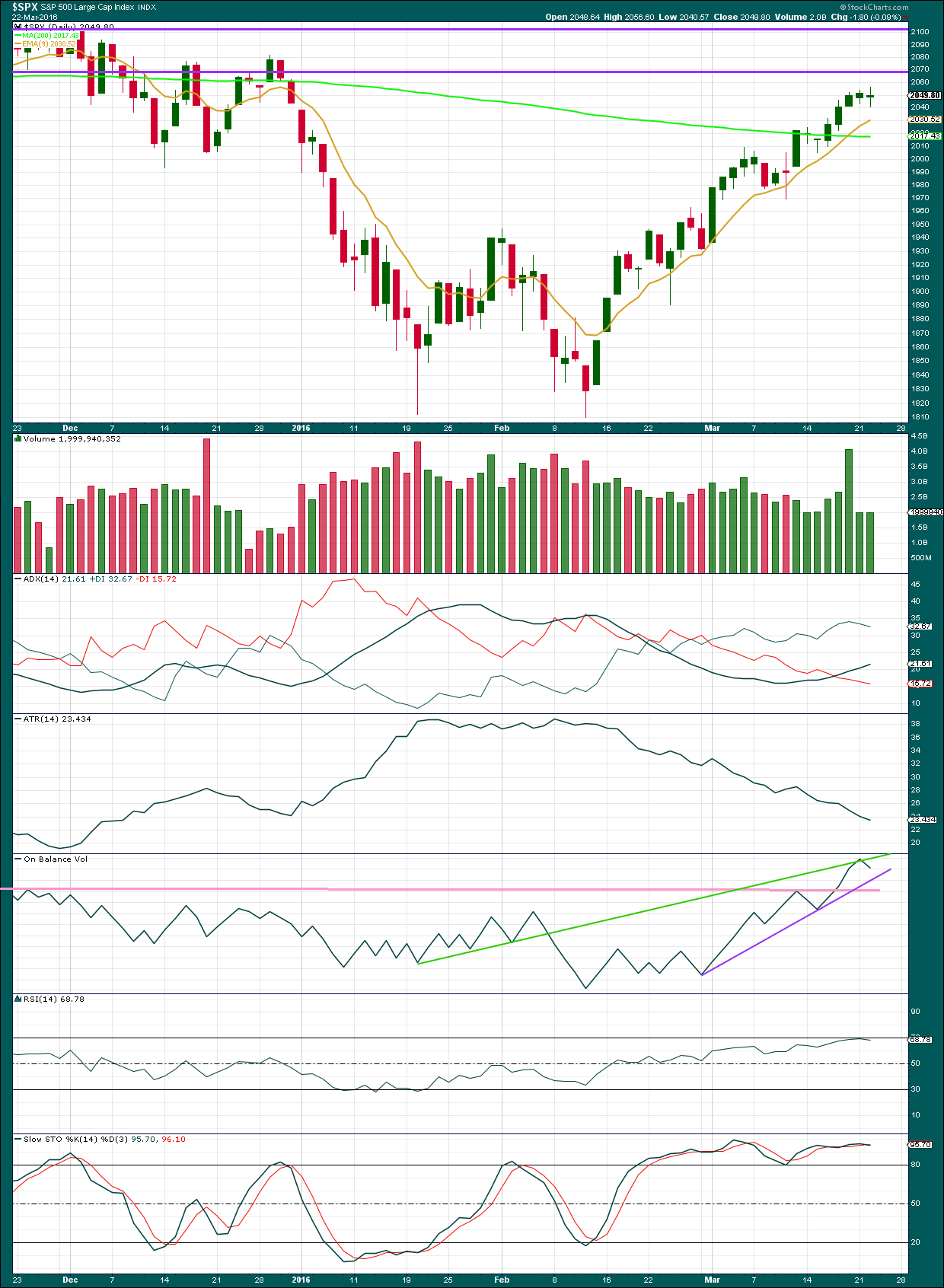
Click chart to enlarge. Chart courtesy of StockCharts.com.
Volume data on StockCharts is different to that given from NYSE, the home of this index. Comments on volume will be based on NYSE volume data when it differs from StockCharts.
A slight increase in volume for Tuesday’s small green candlestick indicates some support for the upwards move in price. The small green doji indicates indecision, a balance between bulls and bears. A doji on its own is not a reversal indicator, so this changes the market outlook short term from up to neutral only.
As price moves higher, the 9 day moving average provides support. Price is now above the 200 day moving average. The 200 day average still is pointing down indicating the market is more likely still bearish.
ADX is still increasing indicating the market is trending, but ATR still disagrees. There is something wrong with this trend. If this is a bear market rally, that makes sense. If the bull market was resuming, then ATR should be increasing and not declining.
On Balance Volume has found resistance at the green trend line and turned down from there. It may find support at the purple line. A break below the purple line by OBV would be a weak bearish signal.
RSI is not yet extreme. Stochastics is, but this may remain extreme for reasonable periods of time during a trending market.
ADVANCE DECLINE LINE
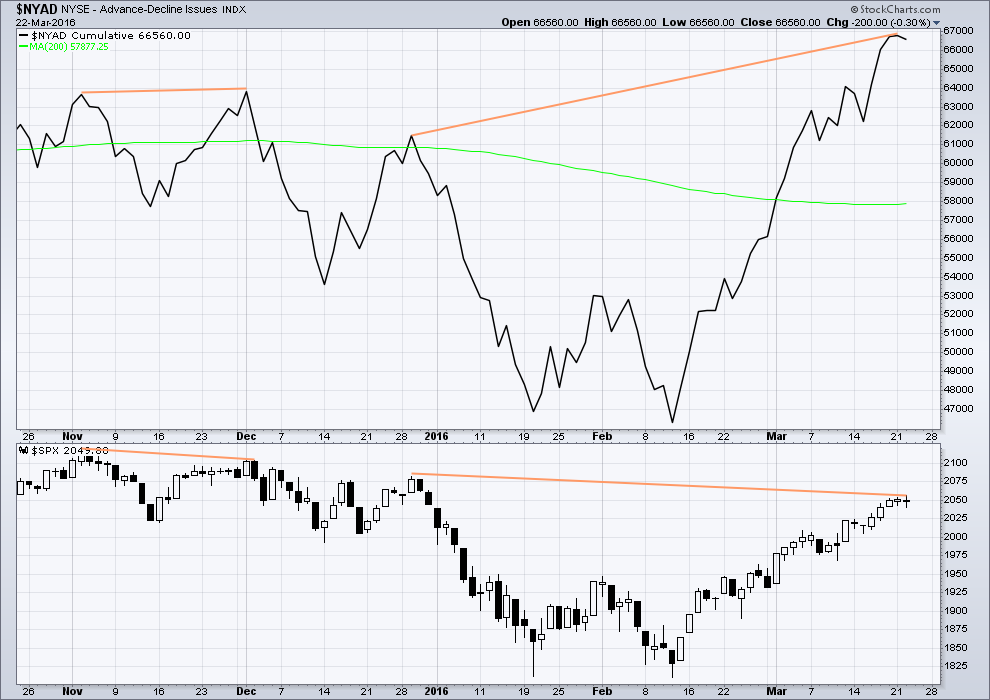
Click chart to enlarge. Chart courtesy of StockCharts.com.
The Advance Decline line shows no short term (day to day basis) divergence with price. With the AD line increasing, this indicates the number of advancing stocks exceeds the number of declining stocks. This indicates that there is breadth to this upwards movement.
Longer term, looking back over the last five months, there are two cases of hidden bearish divergence between price and the AD line.
From November 2015 to December 2015 the AD line made a new high while price failed to make a corresponding high. This indicated weakness in price and preceded new lows for price.
Now again from 29th December, 2015, to now the AD line is making new highs but price has so far failed to also make corresponding new highs. This again is an indication of weakness in price. Despite price rising with market breadth increasing, the breadth increase is not translating to substantial rises in price.
It remains to be seen if price can make new highs beyond the prior highs of 29th December, 2015. If price can manage to do that, then this hidden bearish divergence will no longer be correct, but the fact that it is so strong at this stage is significant. The AD line will be watched daily to see if this bearish divergence continues or disappears.
The 200 day moving average for the AD line is now flat. Even if the 200 day MA points up this alone would not be enough to indicate a new bull market. During November 2015 the 200 day MA for the AD line turned upwards and yet price still made subsequent new lows.
DOW THEORY
I am choosing to use the S&P500, Dow Industrials, Dow Transportation, Nasdaq and the Russell 2000 index. Major swing lows are noted below. So far the Industrials, Transportation and Russell 2000 have made new major swing lows. None of these indices have made new highs.
I am aware that this approach is extremely conservative. Original Dow Theory has already confirmed a major trend change as both the industrials and transportation indexes have made new major lows.
At this stage, if the S&P500 and Nasdaq also make new major swing lows, then my modified Dow Theory would confirm a major new bear market. At that stage, my only wave count would be the bear wave count.
The lows below are from October 2014. These lows were the last secondary correction within the primary trend which was the bull market from 2009.
These lows must be breached by a daily close below each point.
S&P500: 1,821.61
Nasdaq: 4,117.84
DJIA: 15,855.12 – close below on 25th August 2015.
DJT: 7,700.49 – close below on 24th August 2015.
Russell 2000: 1,343.51 – close below on 25th August 2015.
This analysis is published @ 10:51 p.m. EST.

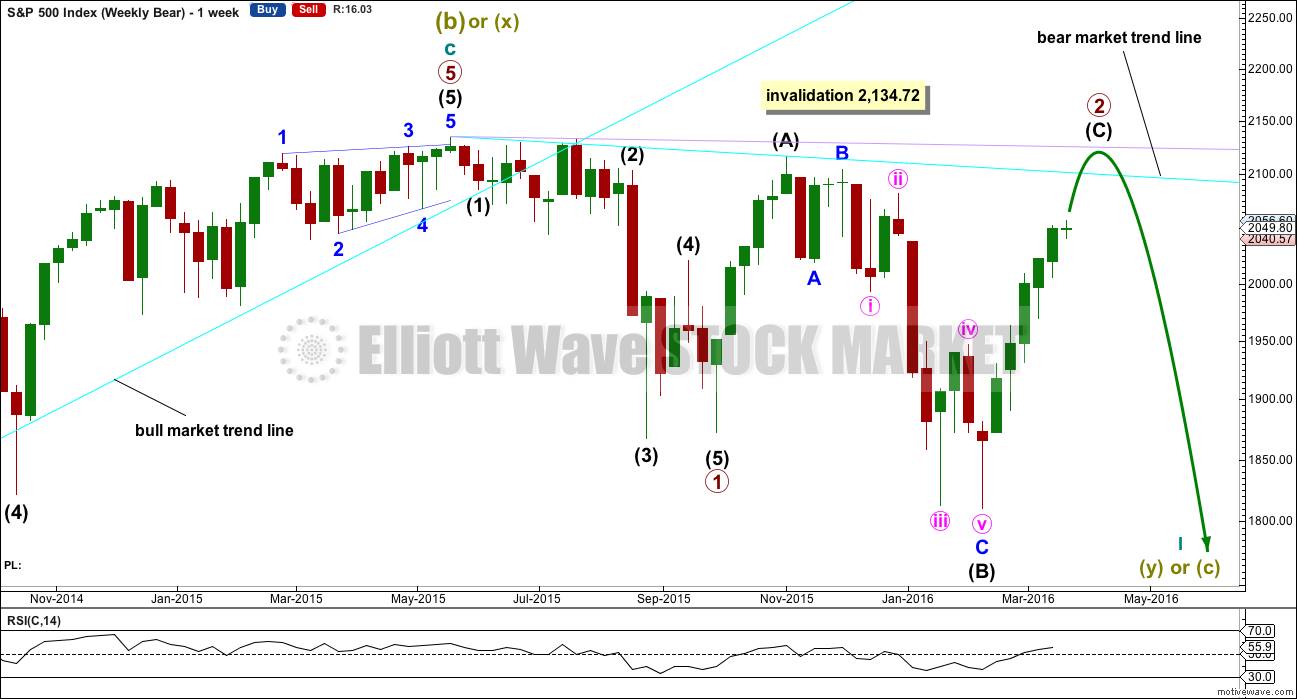
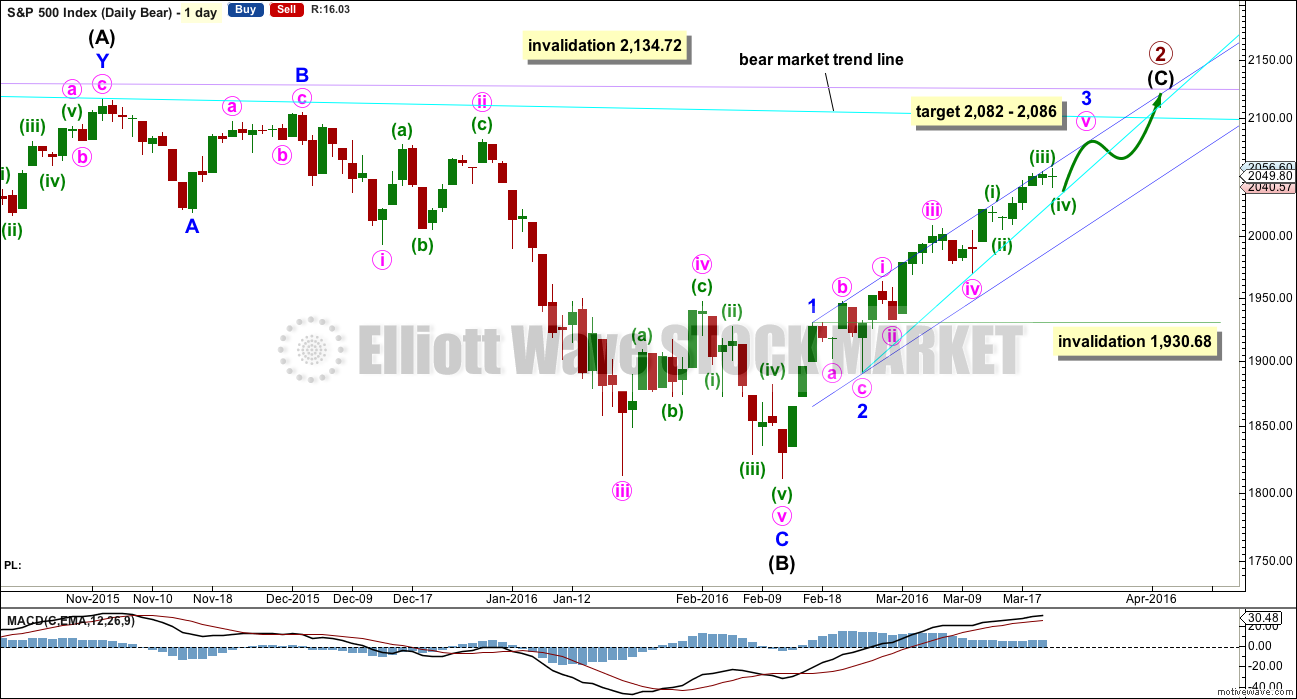
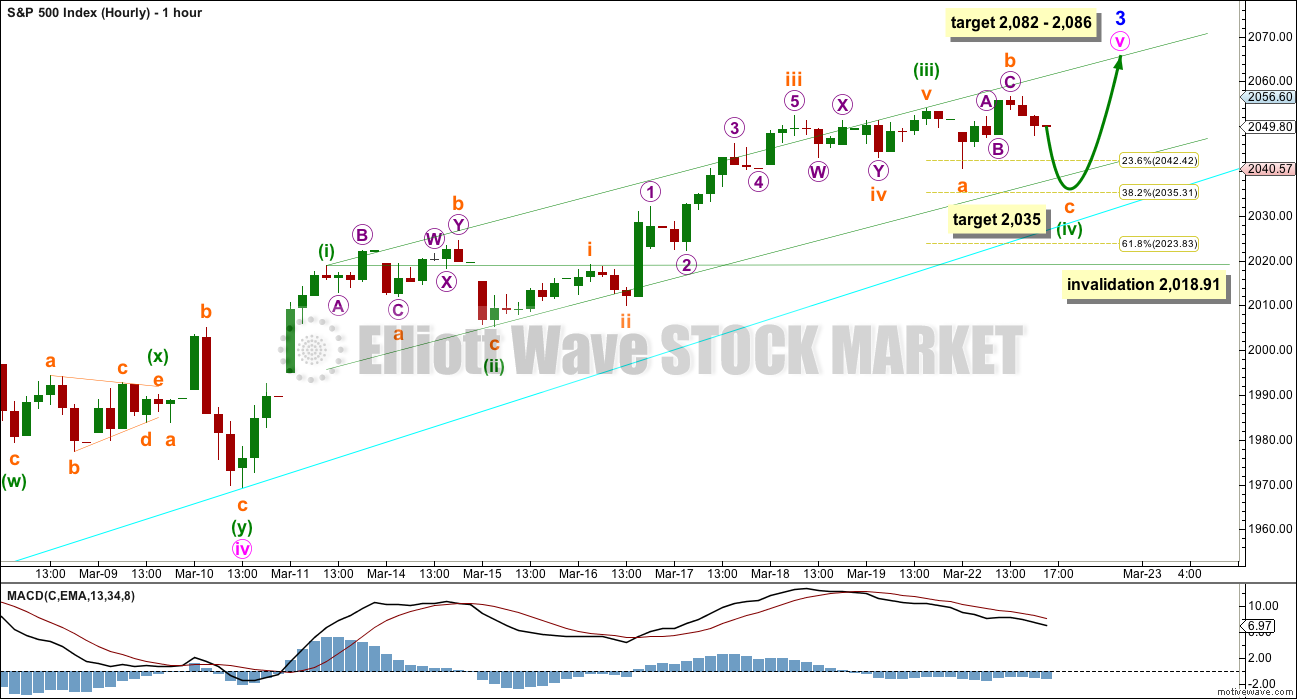
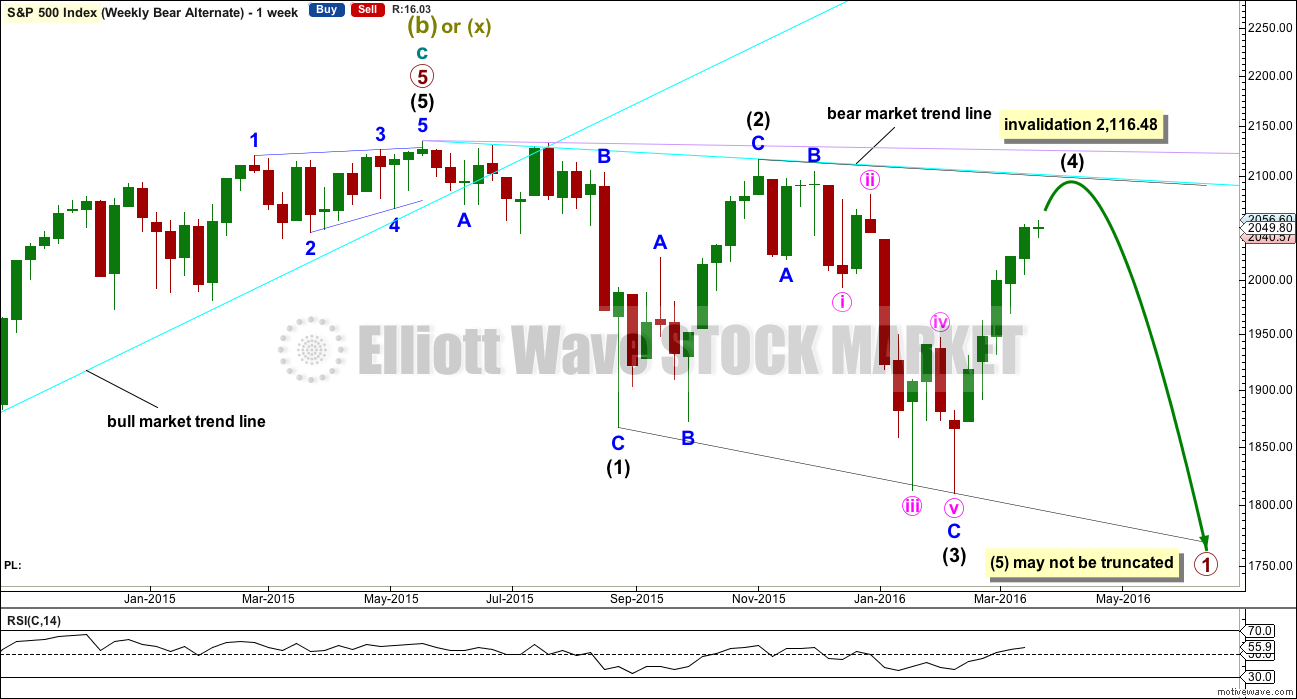
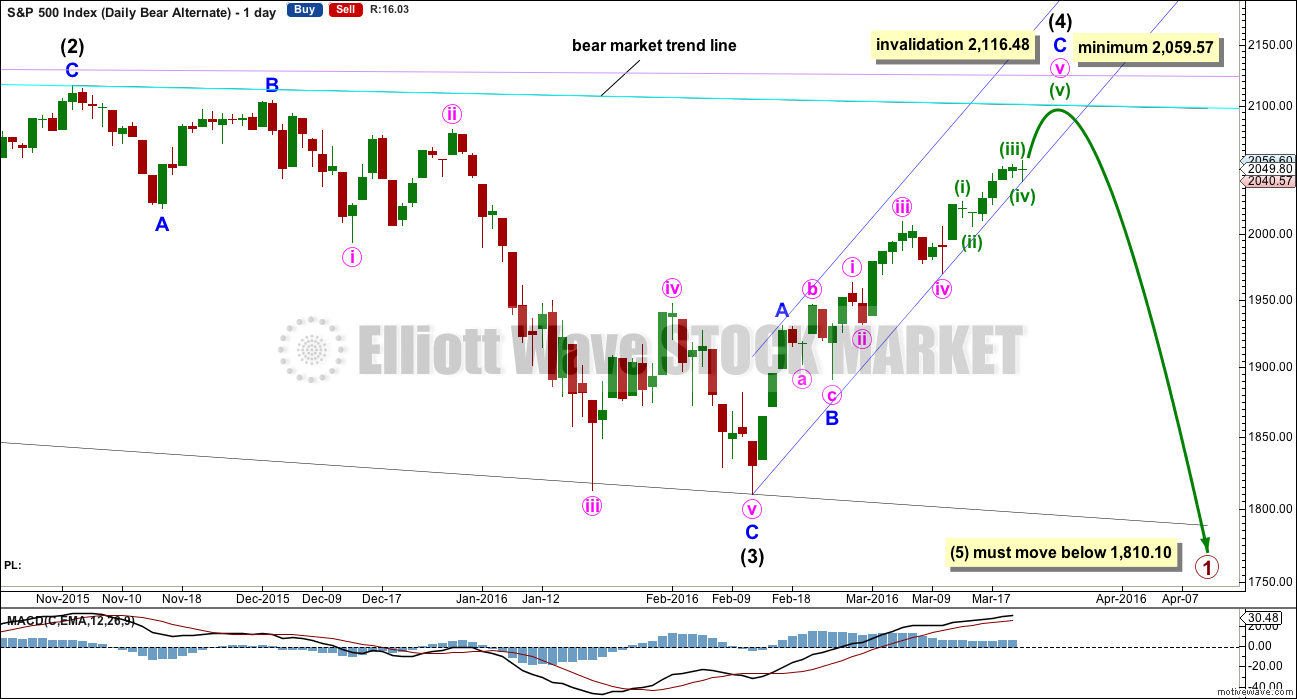
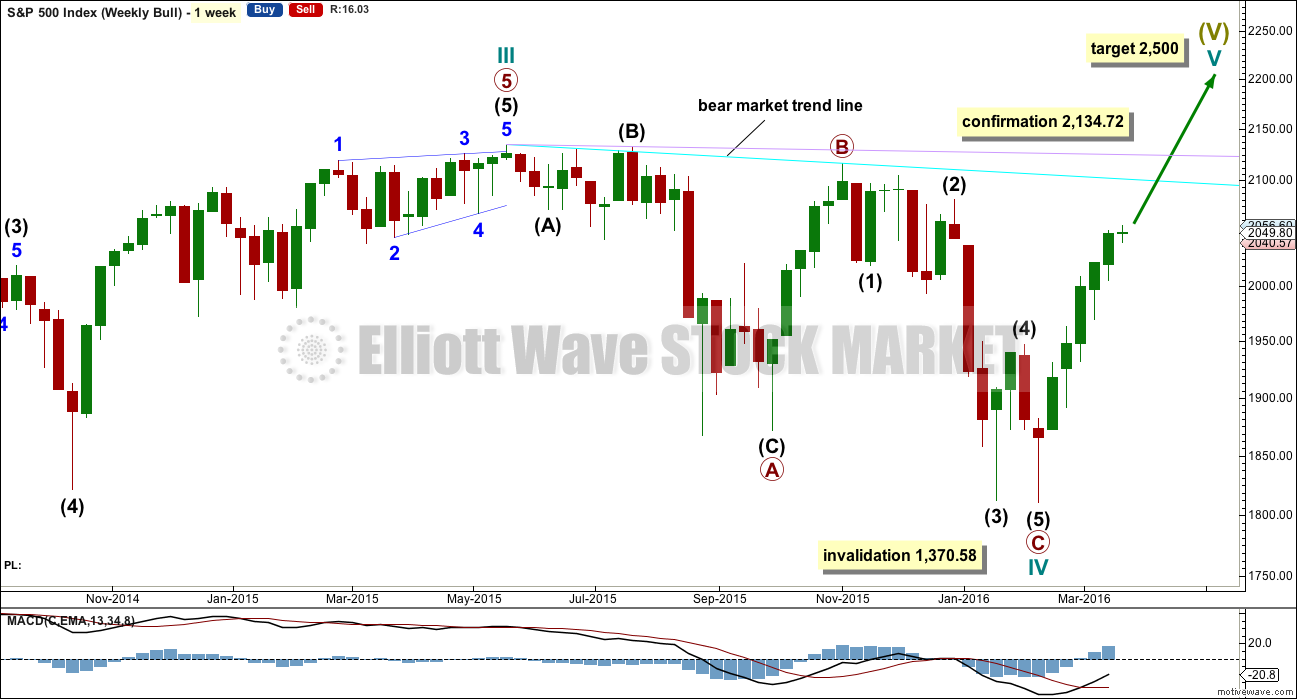
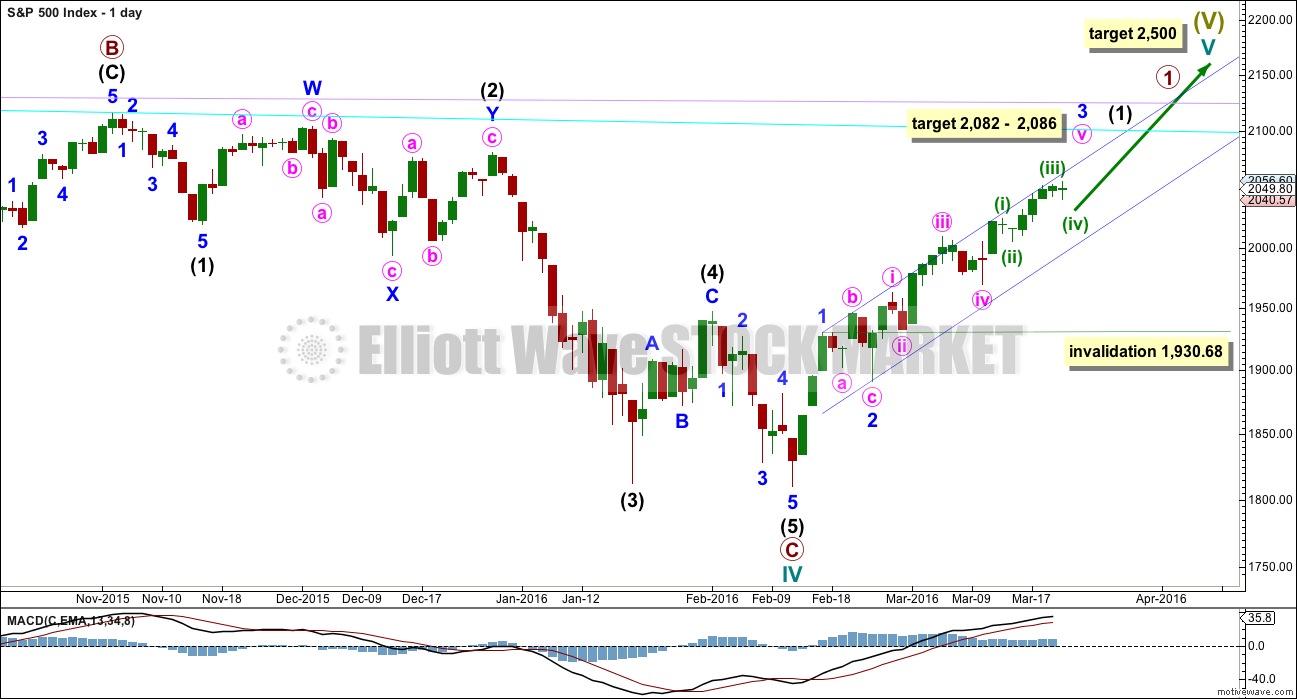
UVXY will print first green candle after new 52 week lows today. We should see at least more intra-day spike down to mark the end of the correction. Opened order to buy April 1 UVXY 25 calls at limit price of 0.50. Additional contingent order to buy at the market if UVXY exceeds 25. Nothing left to do but wait for the market to do what the market will do. Cheerio!
ps. It looks to me like five down and three up today…just saying… 🙂
I don’t like the looks of it either. I show UVXY in a very orderly 5 wave wedge down from its highs, with the last wave appearing to be another 5 wave wedge that completed yesterday. Today shows what I would take as an initial breakout back up if it wasn’t for Lara’s call for another top in the markets.
Betcha if we do get another top in the SPX that UVXY won’t make it back down to its low. I’m getting back into some UVXY calls cause I think the risk is now to the upside, but I’m going for a few weeks’ out.
with a bit of luck, I hope to take initial profits to the downside just about the time the average bear decides it’s time to dip a toe(or two), back in the balmy waters… 😉
Some divergence between S&P price and UVXY or VIX would be a strong indicator of a trend change.
Daily SPX chart, MACD above 30. Rolling over and starting to point down. If it crosses down, that brings a great deal of confidence that the correction is near over or actually over.
The Fear Greed Index is at 72 today. Yesterday’s close was 78. If I recall properly, last week we hit 80.
In late February MACD was below negative 20 and the Fear Greed Index was at 7. I commented that I did not want to enter any more short positions because of these and other momentum / sentiment indicators. I thought I would wait until I we saw MACD at 30+ and Fear Greed Index at 80. Well, those conditions have been met.
My strategy now is to be looking for the down trend of some sort to begin now or soon. I continue to remind myself that these momentum / sentiment indicators can stay at extreme levels for some time. In addition, the saying is a good one, “These indicators work until they don’t.” But the conditions are such that my risk of going short is now reduced because of the conditions / circumstances. There are a lot of ways to reduce risk and increase the reward to risk ratio. Waiting for the rite conditions for the trend to change (or resume) in your favor is a very good risk reduction method. Simple but effective, I think.
Now I am going to leave this boring market to show us the clues with price such as channel break out(s), invalidation and confidence levels, and confirmation points. To these tools I add in Olga, Verne and the host of other commentators on this site. The main indicator for me is Lara’s analysis. What more can a subscriber / trader want out of such a service? I couldn’t ask for more?
Have a great day everyone of you.
Me too Rodney, that’s my approach.
I love this:
“Waiting for the rite conditions for the trend to change (or resume) in your favor is a very good risk reduction method. Simple but effective, I think.”
I’ll heartily second that.
Risk management is the single most important aspect of trading.
Simple price confirmation of a new trend; a classic breakout from a trading range is the simplest and best.
We should see the conclusion of this fourth wave correction this morning. Here’s hoping we get the final wave up starting today and ideally topping tomorrow ahead of the holiday week-end.
Posting in main thread so all can comment
Lara,
Just wondering what your take on FTSE is now? Seems to have been consolidating around the 6200 level for weeks and hasn’t bought into the parabolic rally of the US indices.
Have you an updated count available which suggests direction of breakout?
Short interest is at almost extreme levels and I just can’t see the market handing the majority a gift until everyone has been shaken out and switched long.
THEN it will tank 🙂
Will take a look at FTSE today and publish a chart. Probably chart only.
yo,, first
LOL
There’s a video coming along shortly too…